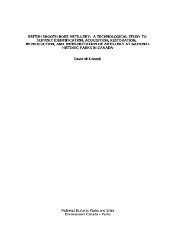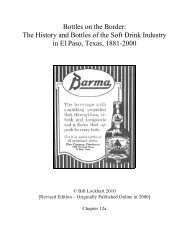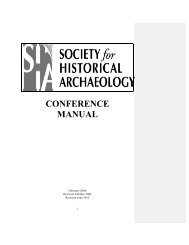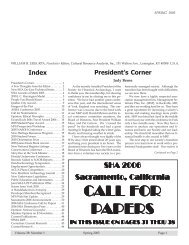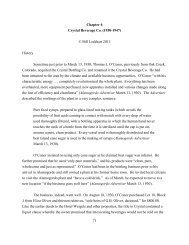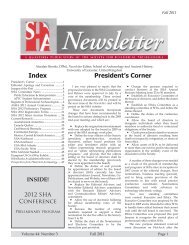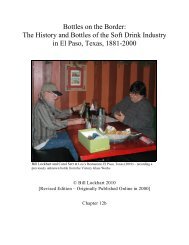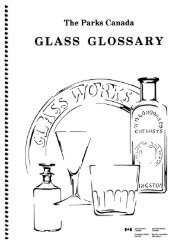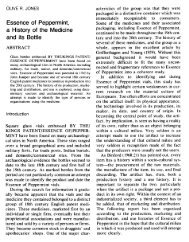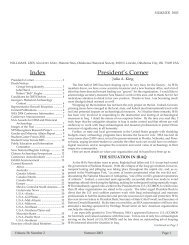1242 Codd Bottles revised
1242 Codd Bottles revised
1242 Codd Bottles revised
Create successful ePaper yourself
Turn your PDF publications into a flip-book with our unique Google optimized e-Paper software.
Photo 3. An extremely rare photograph of Ben<br />
Rylands (seated) and Hiram <strong>Codd</strong><br />
12<br />
ABC - Issue 31<br />
In February 1877 he went into partnership with Hiram <strong>Codd</strong> (see Photo 3).<br />
Hiram held one-fifth of the share capital and Ben retained four-fifths and the<br />
responsibility of management. To fulfil the overwhelming demand for <strong>Codd</strong>’s<br />
newly patented bottle, Ben opened a new works not half a mile up the canal<br />
utilising the latest furnace technology.<br />
Ben died on August 29th 1881 and six months later his son Dan, then 31, took<br />
over but Hiram forced him to pay a huge premium to keep the partnership<br />
agreement in force.<br />
Late in 1884, after Dan and Hiram dissolved their partnership (see Photo<br />
4), Dan Rylands’ name alone was moulded on all bottles made at Stairfoot.<br />
In July 1885 ‘The Useful Patents Co. Ltd.’ of London (owned by Hiram <strong>Codd</strong>)<br />
won a court case against Dan for infringing the <strong>Codd</strong> and Foster patent groove<br />
tool of 1873. Dan retaliated by patenting another tool for the same purpose -<br />
bottles produced by this method are embossed: “PATENT SAFE GROOVE”. Also<br />
in that year <strong>Codd</strong>’s 1871 patent expired and Dan took advantage again and<br />
brought out his Reliance Patent. Early examples of this are embossed: “MADE<br />
BY RYLANDS PATENT PROCESS”.<br />
In 1885 Dan Rylands was supplying <strong>Codd</strong>’s Patent Globe-Stoppered bottles to the whole of the UK (which included London - no<br />
other maker was allowed to do this - a part of the split up agreement) and for export.<br />
Hiram <strong>Codd</strong> died in February 1887.<br />
In July 1888 a company named ‘Dan Rylands<br />
Limited’ was formed to acquire the business<br />
of ‘Dan Rylands’ for the sum of £136,400. Dan<br />
took at least £66,600 of this in shares to remain<br />
as chairman and managing director.<br />
Also in 1888 a prospectus pointed out that<br />
‘since paying out the late Hiram <strong>Codd</strong> in 1884,<br />
Mr. Dan Rylands had increased by 66% the<br />
bottle manufacturing capabilities of the Hope<br />
Glass Works’, which then comprised:- two<br />
large continuous regenerative glass melting<br />
furnaces, three smaller ones, two ordinary<br />
coal furnaces, forty-two annealing kilns, four<br />
sets of Rylands & Potter’s patent kilns, with<br />
sixty patent trucks and four double pairs of<br />
rail for the same, eight Rylands patent gas<br />
producers, sixteen other gas producers, nine<br />
sorting and packing warehouses, three engine<br />
houses, large box factory, wire spinning shed<br />
and stores, engineers’, mould fitters’ and<br />
blacksmiths’ shops, pattern makers’ shop,<br />
Photo 4. The letter sent to all mineral water traders, dissolving the <strong>Codd</strong> and Rylands<br />
partnership in 1884, with original signatures<br />
mould stores, sand/limestone/chemical and mixing stores, globe stoppered grinding room (to grind 3,000<br />
gross weekly – 432,000), a clerk’s office, draughtsman’s office, stables, about 400 light gas works, thirtythree<br />
workmen’s cottages and two managers’ houses! (See Photo 1 for a view of the works several years later).<br />
Dan Rylands at the time was sole owner of ninety-four British and Foreign patents. New capital was raised in 1889 for the<br />
erection of glass melting furnaces specially adapted for the manufacture of bottles by Rylands patented Automated Bottle-<br />
Making machine: this was capable of making 6 bottles per minute.<br />
In January 1892 Dan’s box factory was destroyed in a fire with damages of £16,000 and early in 1893 he experienced his third<br />
workers’ strike in twenty years: this, together with other financial problems, caused him to become bankrupt. He resigned and<br />
in May 1893 attempted to commit suicide. Later that year the Times newspaper stated he had £300,000 liabilities: interestingly<br />
he was also a colliery proprietor and a brick manufacturer.<br />
By 1897 the company was known as ‘The Rylands Glass and Engineering Company Limited’ and from this time their bottles were<br />
marked simply “The Rylands”. In May 1905 the works was taken over by the Wood Brothers from Hoyle Mill, near Barnsley.



